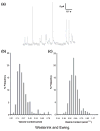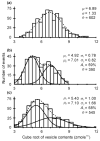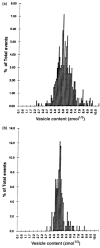The PC12 cell as model for neurosecretion
- PMID: 18005394
- PMCID: PMC2663028
- DOI: 10.1111/j.1748-1716.2007.01805.x
The PC12 cell as model for neurosecretion
Abstract
This review attempts to touch on the history and application of amperometry at PC12 cells for fundamental investigation into the exocytosis process. PC12 cells have been widely used as a model for neural differentiation and as such they have been used to examine the effects of differentiation on exocytotic release and specifically release at varicosities. In addition, dexamethasone-differentiated cells have been shown to have an increased number of releasable vesicles with increased quantal size, thereby allowing for an even broader range of applications including neuropharmacological and neurotoxicological studies. PC12 cells exhibiting large numbers of events have two distinct pools of vesicles, one about twice the quantal size of the other and each about half the total releasable vesicles. As will be outlined in this review, these cells have served as an extremely useful model of exocytosis in the study of the latency of stimulation-release coupling, the role of exocytotic proteins in regulation of release, effect of drugs on quantal size, autoreceptors, fusion pore biophysics, environmental factors, health and disease. As PC12 cells have some advantages over other models for neurosecretion, including chromaffin cells, it is more than likely that in the following decade PC12 cells will continue to serve as a model to study exocytosis.
Conflict of interest statement
Conflict of interest
There is no conflict of interest.
Figures






Similar articles
-
The role of Snapin in neurosecretion: snapin knock-out mice exhibit impaired calcium-dependent exocytosis of large dense-core vesicles in chromaffin cells.J Neurosci. 2005 Nov 9;25(45):10546-55. doi: 10.1523/JNEUROSCI.3275-05.2005. J Neurosci. 2005. PMID: 16280592 Free PMC article.
-
Exocytosis of single chromaffin granules in cell-free inside-out membrane patches.Nat Cell Biol. 2003 Apr;5(4):358-62. doi: 10.1038/ncb956. Nat Cell Biol. 2003. PMID: 12652310
-
Alpha-synuclein overexpression in PC12 and chromaffin cells impairs catecholamine release by interfering with a late step in exocytosis.J Neurosci. 2006 Nov 15;26(46):11915-22. doi: 10.1523/JNEUROSCI.3821-06.2006. J Neurosci. 2006. PMID: 17108165 Free PMC article.
-
Neurosecretory cells without neurosecretion: evidence of an independently regulated trait of the cell phenotype.J Physiol. 1999 Oct 1;520 Pt 1(Pt 1):43-52. doi: 10.1111/j.1469-7793.1999.t01-1-00043.x. J Physiol. 1999. PMID: 10517799 Free PMC article. Review.
-
Antidiuretic hormone and exocytosis: lessons from neurosecretion.Am J Physiol. 1994 Dec;267(6 Pt 1):C1507-24. doi: 10.1152/ajpcell.1994.267.6.C1507. Am J Physiol. 1994. PMID: 7810592 Review.
Cited by
-
Development of a PC12 Cell Based Assay for Screening Catechol-O-methyltransferase Inhibitors.ACS Chem Neurosci. 2019 Oct 16;10(10):4221-4226. doi: 10.1021/acschemneuro.9b00395. Epub 2019 Sep 12. ACS Chem Neurosci. 2019. PMID: 31491076 Free PMC article.
-
Plasticity in exocytosis revealed through the effects of repetitive stimuli affect the content of nanometer vesicles and the fraction of transmitter released.Proc Natl Acad Sci U S A. 2019 Oct 22;116(43):21409-21415. doi: 10.1073/pnas.1910859116. Epub 2019 Sep 30. Proc Natl Acad Sci U S A. 2019. PMID: 31570594 Free PMC article.
-
CellPalmSeq: A curated RNAseq database of palmitoylating and de-palmitoylating enzyme expression in human cell types and laboratory cell lines.Front Physiol. 2023 Jan 24;14:1110550. doi: 10.3389/fphys.2023.1110550. eCollection 2023. Front Physiol. 2023. PMID: 36760531 Free PMC article.
-
Qualitative Assay to Detect Dopamine Release by Ligand Action on Nicotinic Acetylcholine Receptors.Toxins (Basel). 2019 Nov 20;11(12):682. doi: 10.3390/toxins11120682. Toxins (Basel). 2019. PMID: 31757080 Free PMC article.
-
Exposure to high-frequency electromagnetic field triggers rapid uptake of large nanosphere clusters by pheochromocytoma cells.Int J Nanomedicine. 2018 Dec 10;13:8429-8442. doi: 10.2147/IJN.S183767. eCollection 2018. Int J Nanomedicine. 2018. PMID: 30587969 Free PMC article.
References
-
- Albillos A, Dernick G, Horstmann H, Almers W, Alvarez de Toledo G, Lindau M. The exocytotic event in chromaffin cells revealed by patch amperometry. Nature. 1997;389:509–512. - PubMed
-
- Alvarez de Toledo G, Fernandez-Chacon R, Fernandez JM. Release of secretory products during transient vesicle fusion. Nature. 1993;363:554–558. - PubMed
-
- Barclay JW, Morgan A, Burgoyne RD. Calcium-dependent regulation of exocytosis. Cell Calcium. 2005;38:343–353. - PubMed
-
- Berridge MJ, Irvine RF. Inositol trisphosphate, a novel second messenger in cellular signal transduction. Nature. 1984;312:315–321. - PubMed
Publication types
MeSH terms
Substances
Grants and funding
LinkOut - more resources
Full Text Sources
Other Literature Sources
Research Materials

